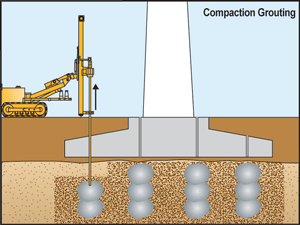Consolidation grouting is a widely used ground improvement technique in geotechnical engineering that focuses on increasing the density and strength of soil by injecting a grout material under pressure. This method is especially useful for stabilizing weak, compressible soils, reducing settlement, and enhancing the load-bearing capacity of foundations, making it a crucial technique for safer and more stable construction.
What is Consolidation Grouting?
Consolidation grouting involves injecting a slurry or grout mixture into the soil at high pressure, filling voids and pore spaces between soil particles. This process improves the soil’s density, strengthens its structure, and reduces the potential for future settlement. Unlike permeation grouting, which seeks to reduce permeability, consolidation grouting primarily aims to enhance the mechanical properties of the soil by compacting it and reducing its compressibility.
How Does Consolidation Grouting Work?
The grout material, typically a cement-based mixture, is injected into the soil through a series of drilled boreholes. The grout displaces the water in the soil pores and fills the gaps, effectively increasing the soil’s density. This process also helps to bind the individual soil particles together, creating a stronger matrix that can better support the weight of structures above.
The grout typically penetrates deeper layers of soil under pressure, reaching different soil strata to consolidate a broader area. Once the grout hardens, it effectively improves the soil’s strength, stability, and resistance to further settlement.
Applications of Consolidation Grouting
1.Foundation Stabilization:
Consolidation grouting is often employed to improve the stability of foundations on weak or loose soil. It can be used in both new construction and foundation repair projects, ensuring that buildings or infrastructure are supported by a more solid base.
2.Settlement Control:
In areas where settlement is a concern, such as soft clays or loose sands, consolidation grouting can mitigate future settlement risks. This is particularly important for structures like bridges, dams, and high-rise buildings that need to remain stable over time.
3.Pre-Construction Ground Improvement:
Before beginning construction on challenging sites, consolidation grouting can be used to improve the soil quality. This preemptive measure ensures that the ground beneath will provide adequate support, reducing the risk of complications during and after construction.
4.Remediation of Old Infrastructure:
For aging infrastructure, such as roads, tunnels, and foundations of existing buildings, consolidation grouting can reinforce the soil and restore its load-bearing capacity, extending the structure’s life.
Benefits of Consolidation Grouting
- Enhanced Stability:
The primary benefit of consolidation grouting is that it significantly strengthens the soil, making it more stable and better able to support heavy structures. This is crucial for ensuring the safety and longevity of buildings and other infrastructure. - Reduction of Settlement Risks:
By densifying the soil and reducing its compressibility, consolidation grouting mitigates the risk of differential settlement, which can lead to cracks, tilting, or even structural failure. - Cost-Effective Solution:
Consolidation grouting is generally more cost-effective than completely replacing the soil or using other deep foundation methods, making it an attractive option for projects with budget constraints. - Minimal Disruption:
The technique can often be carried out with minimal disruption to existing structures or the surrounding environment. The grout injection process is relatively quiet and requires minimal excavation, making it suitable for urban or sensitive sites.
Challenges and Considerations
While consolidation grouting is an effective technique, there are some factors that must be carefully considered:
- Soil Characteristics:
The success of consolidation grouting depends on the type of soil being treated. Highly permeable soils may not respond well to grouting, and the technique may be less effective in soils with large voids or highly fractured rock. - Injection Pressure:
The grout must be injected under the right pressure to avoid damaging the surrounding soil or nearby structures. Excessive pressure can lead to unwanted displacement or fracturing of the soil. - Material Selection:
The choice of grout material is crucial to achieving the desired results. Factors such as soil composition, moisture content, and the depth of treatment must guide the selection of the grout mixture.
Conclusion
Consolidation grouting is a vital ground improvement technique for enhancing soil density and ensuring the stability of structures. Whether for new construction or the repair of existing foundations, it offers an efficient, cost-effective solution to strengthen weak soils and prevent settlement issues. By improving soil strength, reducing compressibility, and ensuring greater load-bearing capacity, consolidation grouting plays a critical role in making construction safer and more reliable. As technology advances, this technique will continue to evolve, offering even more effective solutions for challenging soil conditions.






